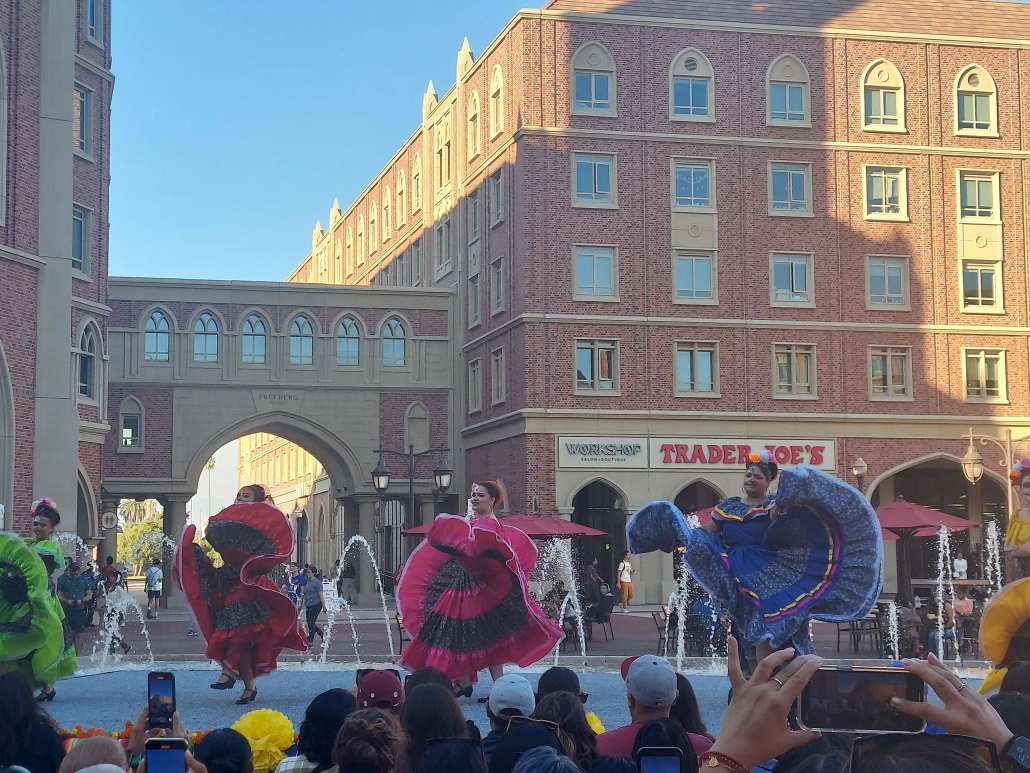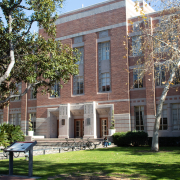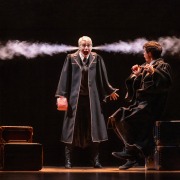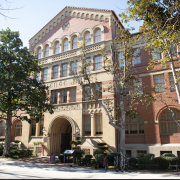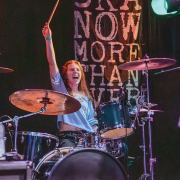Grupo Folklórico de USC inspires pride in culture through communal gatherings
On a usual day, USC Village stands silent, a collection of dorms and retail stores bunched into the trademark red-and-white brick buildings students have come to associate with the University.
But Nov. 5 was not any other day. Donning colorful flowing dresses and skeletal makeup, and with the sound of furious boots stomping along to the music and roaring jeers from the crowd, Grupo Folklórico de USC filled the square with cultural dances and cheers from the South Los Angeles community.
On this day, GFUSC held a Día de los Muertos showcase, a bilingual event open to the community at large. The event showcased different regional dances from the Mexican states of Veracruz, Michoacán, Sinaloa, Hidalgo, Guerrero and Baja.
GFUSC is a Mexican traditional dance group with members from USC and the surrounding communities, instructed by Dahlia Monroy. They have events like the Día de los Muertos showcase so people from USC and South L.A. can come together to celebrate their culture.
“We’re trying to make a space for ourselves at a [primarily white institution] and remind people and other Latinos who are applying to the school like ‘Hey, like this is a PWI, but we’re still here, we’re still claiming this space,’” said Denise Bermudez-Canciobello, GFUSC public relations chair and a junior majoring in computer science games. “We’re still a big part of this University, even though they try to make it seem like we’re not.”
The choice to hold the performance at the Village is a significant one, said Emily Hurtado, GFUSC president and a junior majoring in philosophy, politics, and economics, because it is an affluent place that tries to cater itself to a specific group of people.
“The Village is very expensive, a lot of the stores, a lot of the cafes there are very expensive,” she said. “It’s so important and even beyond just performing at the Village, just having our name here at USC, like we have a folklórico group. It’s showing us that we have a space here, and we are proud to be here.”
GFUSC has had a long and complicated history — so much so that it established a new historian role this year, Hurtado said. Isabel Padilla, the group’s first historian is responsible for trying to figure out GFUSC’s history. Some say that Emilio Pulido, who had started several folklórico groups across Southern California, may have also founded the USC group when he started teaching at USC in 1975.
The group fell away for some time but was reestablished in 2018, and has only grown since then.
Hurtado said folklórico can help people find love and pride in their culture — a simple explanation for the continued interest in folklórico. Hurtado started dancing folklórico when she was six years old because she was struggling with her identity, she said.
“When I was younger, I went to a private Catholic school,” Hurtado said. “And I didn’t like the idea of being Mexican. I hated it, actually. … And my mom saw that and she’s like, ‘Oh, no, that’s not happening.’ And so she actually put me in folklórico just to hope that, ‘Oh, maybe it’ll stick with her, maybe she’ll start to appreciate her culture.’ And that’s exactly what happened.”
For Bermudez-Canciobello, folklórico has helped her learn more about her great-grandmother and her Purépecha heritage, she said.
“The instructor takes the time to tell us about the culture of the dance and even our hair,” Bermudez-Canciobello said. “And I feel like I would have never connected with my ancestral culture had it not been for this. I barely knew anything about the Purépecha tribe until I joined this group.”
For members like Jesse Garcia, GFUSC fundraising chair and a junior majoring in public policy, folklórico can serve as a way to remember home. They immigrated from Mexico to study, and by dancing folklórico, Garcia is able to feel connected to home through familiar movements. Many of the steps for folklórico norteño, which originated in El Norte, where Garcia is from, involve hitting the ground with one’s foot because there’s a lot of dirt in the region.
Folklórico has now become a passion for Hurtado, outside of GFUSC she dances and instructs at the Ballet Folklorico Mexico Azteca company. She also teaches elementary and middle school students folklórico at Camino Nuevo Charter Academy, and she’s even extended an invitation to some of those students to join GFUSC.
“We wanted to make sure that folklórico is for everyone,” Hurtado said. “Anyone can partake in it, college students, undergraduates, graduates, no matter how old you are, how young you are, even if you’re not Mexican at all, just being able to partake in this form of art is just very special. The whole purpose of folklórico is just to learn … so you’re able to share it with other people in the future.”
Keila Rodriguez, a high school student and a part of GFUSC, has been dancing with the group since she was in middle school. GFUSC is very lively, she said, and she loves to watch them and dance with them because of their love for their culture.
“I can connect to my roots, especially when I was born here, and I’ve only gone to Mexico once or twice,” Rodriguez said. “So this is where I can show my roots, know where my ancestors came from, and all that. … I came from Guerrero and Oaxaca, and sometimes there’s a performance for Guerrero, which is really nice because I know where traditional Guerrero folklórico is from and what it looks like.”
However, because GFUSC is so open to having members from the community join, it does make logistics and scheduling space more difficult, said Javier Sepulveda Garibay, GFUSC University advisor and performing arts librarian at USC.
“The way it unfortunately operates here at USC is that they have to practice in a parking structure because there’s a lot of bureaucracy about allowing outsiders into the spaces of the University,” Garibay said. “It can be really, really cold, they have to go practice there. It’s raining, and they have to go practice in the parking lot.”
If it weren’t for GFUSC, USC wouldn’t feel as much like home as it does because of the friends they’ve made in the organization, Garcia said.
“I advocate for this group as much as I can because I think we are more than just a dance group,” said Valeria Macias, a sophomore majoring in journalism and non-governmental organizations and social change. “We’re a very big family on campus. A lot of us are friends outside of this, we go out together, we do everything together. We’re a little Latino family on campus. And that’s very hard to find at USC sometimes.”
Folklórico has become a fundamental part of Hurtado’s life; to be able to show love for her culture and to share it with others has become integral to who she is.
“You can be proud of who you are, and you can be proud of where you come from, it’s not something shameful,” Hurtado said. “People should not be judging you based on where you come from, though it does happen in today’s world, and I feel like organizations like GFUSC just help the community get through it together and just be able to share love for folklórico, for who we are and where we come from.” ❋


